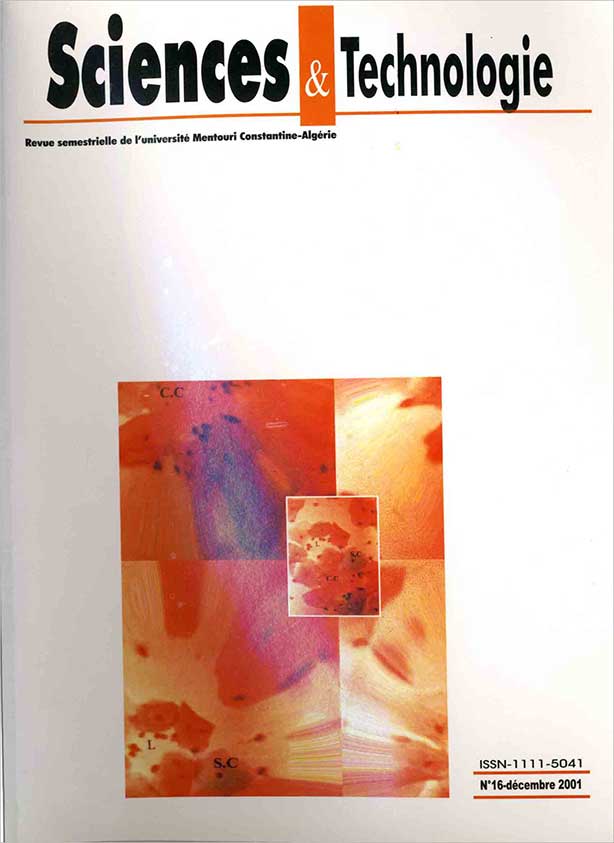ETUDE DU DEVELOPPEMENT DE Lymantria dispar L. (Lepidoptera, Lymantriidae) SUR QUELQUES ESPECES VEGETALES ASSOCIEES AU CHENE-LIEGE
Keywords:
Lymantria dispar, chênes, alimentation, mortalité larvaireAbstract
Lymantria dispar L. (Lepidoptera, Lymantriidae) est un important ravageur du chêne-liège dans la région d’El Tarf (Algérie). Son cycle de développement a déjà été précisé. Lors du retard de débourrement des chênes, espèces végétales préférentielles du ravageur, les chenilles envahissent et consomment d’autres plantes du sous-bois. Différentes espèces végétales ont été testées comme substrat alimentaire des chenilles: le chêne-liège (Quercus suber), le chêne-zeen (Q. faginea), l’aubépine (Crataegus oxyacanta) et le garou (Daphne gnidium). Nos résultats montrent que les chenilles ne consomment pas le garou et que les larves des premiers stades (L1, L2) manifestent une préférence alimentaire pour l’aubépine. Les larves des stades avances (L3 à L5) se développent relativement mieux sur le chêne. Toutefois, le chêne-liège demeure l’aliment le plus consommé. Il assure au ravageur les meilleures performances biologiques.
Downloads
References
- Balachowsky A.S. & Mesnil L., "Les insectes nuisibles aux plantes cultivées", Paris, Mery, Vol.1, (1935), pp. 85-93.
- Barbosa P. & Capinera J.L., "The influence of food on development characteristics of the gypsy moth Lymantria dispar (L.)", Canadian Journal of Zoology, 55, (1977), pp. 1424-1429.
- Barbosa P. & Krischik V.A., "Influence of alkaloids on feeding preference of eastern deciduous forest trees by the gypsy moth Lymantria dispar", American Naturalist, 130, (1987), pp. 53-69.
- Barbosa P., Martina P., & Waldvogel M., "Development, fecundity and survival of the herbivore Lymantria dispar and the number of plant species in its diet.", Ecological Entomology, 11, (1986), pp. 1-6.
- Barbosa P., Waldvogel M., Martinat P. & Douglass L.W., "Developmental and reproductive performance of the gypsy moth, Lymantria dispar (L) on selected hosts common to mid atlantic and southern forest", Environmental Entomology, 12, (1983), pp. 1858-1862.
- Benlahboub-Jazouli H., "Dynamique des populations de Lymantria dispar L. (Lép. Lymantriidae) en lisière de la subéraie de la Mamora", Mémoire d’Ingénieur Phytiatre, Institut Agronomique et Vétérinaire Hassan II, Rabat, Maroc, (1978), 45p.
- Campbell R.C., "Statistics for biologists", Cambridge University Press, (1974), 385p.
- Campbell R.W., "Some effects of gypsy moth density on rate of development, pupation time and fecundity", Annals of the Entomological society of America, 71, (1978), pp. 442-448.
- Capinera J.L., & Barbosa P., "Influence of natural diets and larval density on gypsy moth Lymantria dispar: egg mass characteristics", Canadian Entomologist, 109, (1977), pp. 1313-1318.
-Delassus M., "La lutte contre le Liparis dispar dans le massif de l’Edough", Revue Agricole de l’Afrique du Nord, 23, (1925), pp. 334-352.
-Di-Pietro J.P., "Influence du climat sur les populations de Lymantria dispar", In: "Comptes rendus du séminaire sur Lymantria dispar", Fraval A., Di-Pietro J.P. & Questienne P. (eds), Compte rendu du séminaire tenu à Rabat du 5 au 7 février 1979 sur Lymantria dispar, (1979), 100p.
-Doane C.C., "Aspects of mating behaviour of the gypsy moth", Annals of the Entomological Society of America, 61, (1968), pp. 768-773.
-Elkinton J.S. & Liebhold A.M., "Population dynamics of gypsy moth in North America", Annual Review of Entomology, 35, (1990), pp. 571-596.
-Fraval A., "Dénombrement de Lymantria dispar en suberaie atlantique", In: Comptes rendus du séminaire sur Lymantria dispar. In : Fraval A. Di-Pietro J.P. & Questienne P. (eds), Compte rendu du séminaire tenu à Rabat du 5 au 7 février 1979 sur Lymantria dispar, (1979), 100p.
-Fraval A., "Influence de la qualité et de la quantité de l’alimentation sur les fluctuations des populations de Lymantria dispar en forêt de la Mamora (Maroc)", Agronomie, 4, (1984), pp. 819-828.
-Fraval A., "Lymantria dispar", Actes Editions, Rabat, Maroc, (1989), 220p.
-Hajek A.E., "Effects of transferring gypsy moth, Lymantria dispar, larvae between artificial diet and Quercus rubra foliage", Entomologia Experimentalis Applicata, 51, (1989), pp. 141-148.
-Hamra Kroua S., "La bioécologie de la « Spongieuse » Lymantria dispar dans les forêts de chêne-liège dans le nord constantinois", Thèse de Magister, Université de Constantine Algérie, (1989), 98p.
-Hough J.A. & Pimentel D., "Influence of host foliage on development, survival, and fecundity of the gypsy moth", Environmental Entomology, 7, (1978), pp. 97-102.
-Lechowicz M. & Jobin L., "Estimating the susceptibility of tree species to attack by the gypsy moth, Lymantria dispar", Ecological Entomology, 8, (1983), pp. 171-183.
-Leonard D.E., "Recent developments in ecology and control of the gypsy moth", Annual Review of Entomology, 19, (1974), pp. 197-229.
-Markovic I., Norris D.M. & Cekic M., "Some chemical bases for gypsy moth Lymantria dispar, larval rejection of green ash, Fraxinus pennsylvanica, foliage as food", Journal of Chemical Ecology, 22, (1996), pp. 2283-2298.
-Mattson W.J. & Haack R.A., "The role of drought stress in provoking outbreaks of phytophagous insects", In: Barboza P. & Schultz J.C. (eds), Insect outbreaks, Academic Press, New York, (1987), pp. 365-394.
-Mauffette Y. & Lechowicz M.J., "Host preferences of gypsy moth, Lymantria dispar in Southern Quebec", Canadian Journal of Forest Research, 13, (1983), pp. 53-60.
-Meyer G.A. & Montgomery M.E., "Relationships between leaf age and the food quality of cottonwood foliage for the gypsy moth, Lymantria dispar", Oecologia, 72, (1987), pp. 527-532.
-Miller J.S. & Feeny P., "Effects of benzylisoquinoline alkaloids on the larvae of polyphagous Lepidoptera", Oecologia, 58, (1983), pp. 332-339.
-Montgomery M.E. & Wallner W.E., "The gypsy moth: a westard migrant", In: Berryman A.A. (ed.), Dynamics of forest insect populations, Wiley, New York, (1988), pp. 354-375.
-Noris D.M., "Anti-feeding compounds", In: Haug H. et Hoffman H. (eds), Chemistry of plant protection, Springer-Verlag, Berlin, (1986), pp. 99-146.
-Ouakid M.L., "Etude d’un ravageur des forêts: Lymantria dispar (Lepidoptera, Lymantriidae). Bioécologie dans la forêt de la Gourrah action des facteurs écologiques et activité du Thuricide HP et du Dimilin", Thèse de Magister, Université de Annaba, Algérie, (1991), 87 p.
-Peterson C. & Haenscher G.J., "Some observation of the larval instar of the oriental peach moth Laspeyressia molesta", Journal of Economical Entomology, 21, (1982), pp. 483-452.
-Questienne P., "Lymantria dispar dans le monde et au Maroc", In : Fraval A. Di-Pietro J.P. & Questienne P. (eds), Compte rendu du séminaire tenu à Rabat du 5 au 7 février 1979 sur Lymantria dispar, (1979), 100 p.
-Raffauf R.F., "A handbook of alkaloids and alkaloid-containing plants", Wiley, New York, (1970), 254p.
-Raupp M.J., Werren J.H. & Sadof C.S., "Effects of short-term phenological changes in leaf suitability on the survivorship, growth and development of gypsy moth (Lepidoptera: Lymantriidae) larvae", Environmental Entomology, 17, (1988), pp. 316-319.
-Ridet J.M., "Etude des conditions optimales d’élevage et d’alimentation de Lymantria dispar", Annales de la société Entomologique de France, 8, (1972), pp. 653-668.
-Saxena K.N., Khattar P. & Goyal S., "Measurement of orientation responses of caterpillars indoors and outdoors on a grid", Experientia, 33, (1976), pp. 1312-1313.
-Schaffer P.W., Weseloh R.M., Sun X., Wallner W.E. & Yan J., "Gypsy moth in the people’s Republic of China", Environmental Entomology, 13, (1984), pp. 1535-1541.
-Seurat L., "Exploration zoologique de l’Algérie", Vol. 1, Masson et Cie (eds), Paris, (1933), 707 p.
-Villemant C., "Les prédateurs-démanteleurs des pontes de Lymantria dispar en subéraie de Mamora (Maroc)", Bulletin de la Société Zoologique de France, 123, (1998), pp.75-81.








